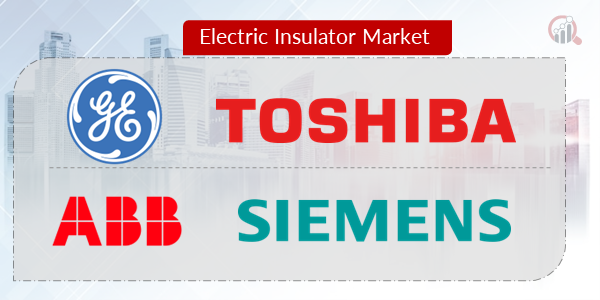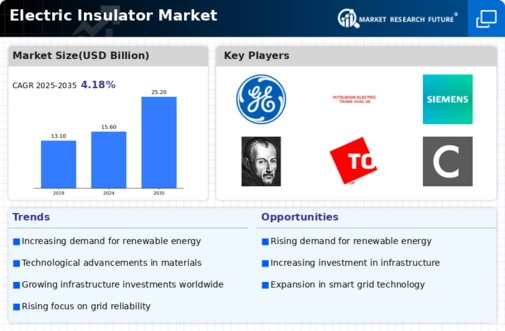Top Industry Leaders in the Electric Insulator Market

*Disclaimer: List of key companies in no particular order
The electric insulator market is a vital component in ensuring the safe and efficient transmission and distribution of electricity. Despite its seemingly simple nature, this market is intricate, with diverse players, evolving technologies, and regional variations. For both established and emerging companies to thrive in this dynamic environment, a comprehensive understanding of the competitive landscape is paramount.
Key Players and Strategies:
Prominent players in the electric insulator market include-
ABB (Switzerland)
General Electric (US)
Siemens (Germany)
NGK Insulators (Japan)
Hubbell (US)
Toshiba (Japan)
Bharat Heavy Electricals Limited (India)
Lapp Insulators (Germany)
Maclean Fogg (US)
Southwire Company (US), and others.
Dominating the market are global giants like NGK Insulators, Lapp Group, and Amica Holding Corporation, leveraging economies of scale and established distribution networks. Strategies employed by these players often revolve around product diversification to cater to a broad range of voltages and applications. NGK, for example, focuses on high-voltage composite insulators for renewable energy projects, while Lapp Group emphasizes advanced bushing and conductor technologies.
Regional players, such as China's Jingdezhen Insulator and India's Transpower Ltd., carve their niche through cost-competitive strategies. Capitalizing on lower production costs, they cater to local demand and compete based on price sensitivity. Jingdezhen, for instance, serves the burgeoning low- and medium-voltage insulator market in China, while Transpower Ltd. focuses on providing affordable solutions for India's power grid expansion.
In addition to established players, innovative startups are emerging, challenging the traditional landscape. These companies often specialize in niche applications or emerging technologies. For example, Armatures Insulators develops cutting-edge composite insulators for extreme environments, while Nanostone Technologies focuses on nanocomposite materials for improved insulator performance.
Market Share Analysis:
Several factors influence market share analysis in the electric insulator market. Geography, with Asia-Pacific leading due to rapid infrastructure development and increasing electricity demand, plays a significant role. Individual country growth trajectories and government policies within regions further impact market share dynamics.
Product type also plays a crucial role. While ceramic insulators retain a significant share, composite insulators are gaining traction due to their lighter weight, superior mechanical properties, and better environmental performance. This shift necessitates strategic adaptation from players, with some specializing in composite technologies to capture market share.
Furthermore, the specific application segment affects market share. Transformers, transmission lines, and distribution networks each have unique insulator requirements. Companies focusing on specific segments, like Lapp Group's strength in bushings for transformers, can gain an edge over competitors with broader portfolios.
New and Emerging Trends:
The electric insulator market is witnessing exciting technological advancements that are shaping the competitive landscape. Sustainability is a key driver, with developments in bio-based and recycled materials offering eco-friendly alternatives. Companies like NGK are investing in bio-resin insulators, while Armatures Insulators focuses on recycled composite materials.
Automation and smart grids are also shaping the market. The integration of sensors and monitoring systems into insulators facilitates predictive maintenance and real-time data analysis, enhancing grid reliability and efficiency. Companies like Lapp Group are actively incorporating smart functionalities into their product lines.
The growing adoption of renewable energy, particularly solar and wind power, presents unique challenges and opportunities. Insulators for these applications require specific properties to withstand harsh environmental conditions and fluctuating power cycles. Companies like Amica Holding Corporation are adapting their technologies to cater to the demands of the renewable energy sector.
Overall Competitive Scenario:
The electric insulator market is characterized by intense competition with diverse players vying for market share. Established players leverage their brand recognition and global reach, while regional players compete on cost and local expertise. The emergence of innovative startups adds further dynamism to the landscape, challenging traditional approaches with niche technologies.
Success in this competitive environment demands constant adaptation and strategic focus. Companies need to identify their core strengths, target specific market segments, and invest in emerging technologies. Collaboration and partnerships can also be vital, allowing companies to leverage complementary strengths and reach new markets.
By understanding the key players, market share drivers, and emerging trends, companies can navigate the competitive landscape of the electric insulator market and carve out their niche for sustainable growth.
Industry Developments and Latest Updates:
ABB (Switzerland):
- Date: November 22, 2023
- Source: ABB News
- Development: ABB partnered with China's State Grid Corporation to provide digital solutions for optimizing insulator performance and preventing failures in high-voltage transmission lines. This project aims to leverage AI and IoT technologies for real-time monitoring and predictive maintenance.
General Electric (US):
- Date: December 12, 2023
- Source: GE Renewable Energy press release
- Development: GE launched a new line of composite insulators designed for offshore wind applications. These insulators offer improved resistance to saltwater corrosion and harsh weather conditions compared to traditional porcelain insulators.
Siemens (Germany):
- Date: October 25, 2023
- Source: Siemens Smart Infrastructure website
- Development: Siemens introduced a new digital platform for insulator condition monitoring and asset management. This platform utilizes sensor data and analytics to predict potential failures and optimize maintenance schedules for improved grid reliability.

